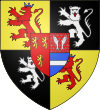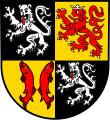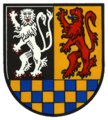Rheingrafen
|
Territory in the Holy Roman Empire |
|
|---|---|
| Rhine County | |
| coat of arms | |

|
|
| map | |

|
|
| Territory of the Wild and Rhine Counts (blue) around 1400
|
|
| Arose from |
Nahegau 1350/1409: Wildgrafsch. 1459: Obersalm 1478: Finstingen |
| Ruler / government | Count |
| Today's region / s |
DE-HE , DE-RP
|
| Reichskreis | Upper Rhine |
| Capitals / residences | Rheinberg , Rheingrafenstein |
| Dynasties |
Emichonen 1350/1409: Rheingrafen
|
| Incorporated into | 1794: France 1815: Prussia , Bavaria , Oldenburg , Hessen-Darmstadt , Saxony-Coburg .
|
The Rheingrafen were a noble house that emerged from the Embrichonen dynasty, who appeared as counts in the Rheingau in the 11th century . By marriage, the title passed to the Lords of Stein on the lower Nahe. When they came into the inheritance of the extinct Wildgraves at the beginning of the 15th century , they called themselves Wildgraves and Rhine Counts . In 1459/1475 they came into the inheritance of the Counts of Salm (Obersalm) and then called themselves Counts of Salm .
history
The name Rheingrafen resulted from its origin in the Rheingau. The originally non-hereditary office of a (Gau-) Count was in the Rheingau before the Veronese donation in 983 regularly in the hands of the Conradines , then soon in the hands of the Embrichonen, who were resident in the Geisenheim area as ministerials of the Archbishop of Mainz . The Castle Johannisberg is possibly their family seat.
The Rheingrafen were dependent on Kurmainz . As a fiefdom they came into possession of Rheinberg Castle near Lorch in 1170 . As an expression of his immediate territorial rule, the Archbishop established and strengthened the non-hereditary office of its governor, the Vice-Cathedral , which was repeatedly awarded to the Rhine Counts until 1318. With the extinction of the first male line of the Rheingraf, the title Rheingraf passed to the Lords of Stein, whose center of power was no longer on the Rhine, but on the Nahe.
Konradines as counts in the Rheingau
-
Gebhard (attested in 888, † (June 22nd, 910 near Augsburg ), 897 and 906 count in the upper Rheingau , 909 count in the Wetterau , 903 duke in Lorraine dux regni quod a multis Hlotharii dicitur ("Duke of the kingdom, that of many that is called Lothar “, which means the Lotharii Regnum, the later Lorraine), had a Salvator Church consecrated in Wetzlar in 897 .
-
Udo , his son; † 949, 914 Graf in der Wetterau , 917 and 948 Graf im Rheingau , 918 Graf im Lahngau , founds the monastery Sankt Maria in Wetzlar in 914/915 , where he was buried, ⚭ NN von Vermandois , daughter of Count Heribert I. ( Carolingian )
- Konrad, Kuno I., Gebhard's great-nephew; † probably 982, 961 Vogt of Schwarzach am Main , 948–951 Count in Rheingau , 973 Count in Ortenau , ⚭ Judith of Thuringia
- Konrad, his son, † 20-08-997, 983 count, 985 and 995 count in the Rheingau, 987 count in the Ufgau , 994 count in the Ortenau ⚭ Adelheid; - is perhaps identical to Kuno von Öhningen, Duke Konrad of Swabia
- Drutwin, his cousin, Count in Rheingau 992, Lord of Lipporn, Count in Königssondergau December 29, 991, 995 († before 1017); Relative of Archbishop Ruprecht von Mainz (970–975)?
- Konrad, Kuno I., Gebhard's great-nephew; † probably 982, 961 Vogt of Schwarzach am Main , 948–951 Count in Rheingau , 973 Count in Ortenau , ⚭ Judith of Thuringia
-
Udo , his son; † 949, 914 Graf in der Wetterau , 917 and 948 Graf im Rheingau , 918 Graf im Lahngau , founds the monastery Sankt Maria in Wetzlar in 914/915 , where he was buried, ⚭ NN von Vermandois , daughter of Count Heribert I. ( Carolingian )
Embrichonen as Ministeriale of the Kurstift Mainz: Counts in the Rheingau and first Rhine Counts
- Embricho I. Graf im Rheingau 1019 († before 1052) ⚭ Adelind
- Ludwig I. Graf im Rheingau 1050 († before 1083)
- Ludwig II. Count in the Rheingau 1076–1104 ⚭ Sophia
- Danckmodis († from 1109) ⚭ Richolf "Rheingaugraf" 1109 († after 1109)
- Ludwig III. Graf im Rheingau 1109 († after 1140) ⚭ Ludgardis
- Riclindis († 1126)
- Embricho III. Count in the Rheingau, († 1157) ⚭ Lucard; from 1124 also "Rheingraf Embricho" I. Embricho is listed among the ministerials despite the title Comes Reni or Ringreve , namely after the Vizedom , in 1131 even after the Schultheiß and the Walpoden .
- Embricho IV. (Embricho II. Rheingraf the Elder), * after 1137, † 1194 without heirs, was still a minor in 1158 after the death of his father under the tutelage of Conrad von Heppenheft and Embricho von Winkel
- Lukardis ⚭ Siegfrid vom Stein ( further under Rheingrafen vom Stein)
- Werner Rheingraf the Younger, 1171 (before 1194)
- Werner, Rheingraf the Younger († 1223 without descendants)
- Embricho III. Count in the Rheingau, († 1157) ⚭ Lucard; from 1124 also "Rheingraf Embricho" I. Embricho is listed among the ministerials despite the title Comes Reni or Ringreve , namely after the Vizedom , in 1131 even after the Schultheiß and the Walpoden .
- Embricho II. Count in the Rheingau († before 1117)
- Ruthard († 1109), Archbishop of Mainz
- NN => Gentlemen from Heppenheft?
- Danckmodis († from 1109) ⚭ Richolf "Rheingaugraf" 1109 († after 1109)
- Ludwig II. Count in the Rheingau 1076–1104 ⚭ Sophia
After the male line became extinct, they were inherited by the Lords of the Stone.
Gentlemen from the stone
- Wolfram I (III.) Vom Stein (de Petra) († around 1179)
- Siegfried I. Stein († around 1194/98) ⚭ 1160 Rhine Countess Lukardis († 1194) ( on the next section)
The Lords of Stein had their ancestral seat in the castle on the Nahe, later called Rheingrafen-Stein .
Rheingrafen vom Stein
- Siegfried I vom Stein († around 1194/98),
- ⚭ around 1160 Rhine Countess Lukardis († 1194), daughter of Rhine Count Embricho I.
- Wolfram III. (V.) vom Stein, from 1194 Rheingraf, the Elder (around 1166; † 1220/21), participates in the Third Crusade from 1189–1191 ,
- ⚭ around 1187 Guda (Jutta) von Bolanden († around 1219), daughter of Count Werner II. Von Bolanden († 1198) and Guda von Weissenau († 1190 or 1198/99), sister of the Reichstruchsess Werner III. von Bolanden († 1212).
|
Rheingrafensteiner Line
|
Rheinberger line (with part of the Rheingrafenstein)
|
- Rhine Count Johann I von Stein (* around 1270; † 1333),
- ⚭ 1310 wild countess Hedwig von Dhaun-Grumbach († around 1361/65), daughter of wild count Konrad IV. Von Dhaun-Grumbach and Hildegard von Hunolstein; she ⚭ II. 1338 Gerlach von Braunshorn .
The Rheingrafen vom Stein lost their property in the Rheingau to Archbishop Werner von Eppstein and Kurmainz in 1279 after the Battle of Sprendlingen , but were able to keep their property on the Nahe, around Kreuznach and Kirn .
Wild and Rhine Counts
In 1350 and 1409 the Rhine Counts inherited the two lines of the Wildgrafen and henceforth called themselves Wild- and Rheingrafen . After the losses of 1279, a great rule had emerged again.
- Rhine Count Johann II vom Stein (* around 1314 - † 1383), Wild Count of Dhaun-Grumbach,
- ⚭ I. before 1339 Wildgravine Margarethe von Dhaun-Kyrburg, heiress of half the Wildgrafschaft Kyrburg, daughter of Wildgrave Friedrich I. von Dhaun-Kyrburg († after 1365) and Agnes von Schönecken († after 1351).
- ⚭ II. 1370 Jutta von Leiningen († after 1390), daughter of Count Friedrich VIII. Von Leiningen-Dagsburg († 1397) and Countess Jolanthe von Jülich († 1387).
- His brothers were Hartrad vom Stein († 1372/75) and the owner of the Kreuznacher and Kirner parish beneficiaries Rheingraf Konrad vom Stein († 1395). Rheingraf Konrad, together with the widowed Rhine Countess Jutta von Leiningen, became the guardian of his nephews in 1383 and often appeared in this role as liege lord of the county.
- Wild and Rhine Count Johann III. von Dhaun-Kyrburg (* 1371; † 1428), since 1409 in possession of all wildgraves' lands,
- ⚭ 1406 Wild Countess Adelheid von Kyrburg (* around 1389; † 1438), daughter of Wild Count Gerhard III. von Kyrburg († 1408) and Adelheid von Veldenz.
- His brother Konrad III. von Dhaun was Archbishop of Mainz 1419-1434 , his brother Friedrich I († 1447) founder of the Rheingrafenstein line.
- Wild and Rhine Count Johann IV. Von Dhaun (* around 1409/10; † 1476),
- ⚭ 1432 Elisabeth von Hanau-Münzenberg (* around 1416; † 1446), daughter of Count Reinhard II. Von Hanau-Münzenberg († 1451) and Countess Katharina von Nassau-Beilstein († 1459).
In 1459 half of the property of the Counts of Salm in the Vosges fell to the Counts of Wild and Rhine by marriage . They then took over their names and called themselves Counts of Salm . In 1475 the game and Rhinegrave of Dhaun-Grumbach were by an imperial edict in the imperial counts charged.
- Wild and Rhine Count Johann V. von Dhaun-Kyrburg (* 1436, † 1495), Count of Salm,
- ⚭ 1459 Jeannette von Salm-Obersalm (* around 1436, † 1496), daughter of Count Simon III. to Salm and Jeanne van Rotselaer.
In 1478, through marriage to Johanna von Moers- Saar Werden, they also acquired the imperial rule of Finstingen on the upper Saar .
- Count Johann VI. von Salm (* 1460; † 1499), Wild and Rhine Count of Dhaun-Kyrburg,
- ⚭ 1478 Johanna von Moers-Saar Werden (* around 1464/65; † 1510/13), mistress of Finstingen, daughter of Count Nikolaus von Moers-Saar Werden († 1495) and Barbara von Vinstingen († 1491).
|
Counts of Salm-Dhaun-Neufville
|
Counts of Salm-Kyrburg
|
Around 1500 the borders of the Dhaun-Grumbach rule extended from the Nahe over the Vosges to the Rhine thanks to a clever family policy. The former borders of the Nahegau had long been blurred. As a result of marriage, new dominions arose soon here, now there, and these were separated from one another just as quickly by partition agreements.
In 1556 the Reformation was introduced in Dhaun-Grumbach. The Wild and Rhine Counts were among the evangelical princes who, at the Diet of Augsburg in 1548, represented "pure doctrine" to the emperor as guardians of the universal church.
In 1623 a line of counts was raised to the rank of imperial prince.
Principality of Salm
At the end of the Old Kingdom , their territories fell to France at the end of the 18th century and the counts were compensated with a newly created principality on the territory of the former principality of Münster (see → Principality of Salm ). With the decision of the Congress of Vienna , the widely scattered territories of the former Wild and Rhine Counties came to the Prussian province of Grand Duchy of Lower Rhine , the Bavarian Rhine District , the Oldenburg exclave Principality of Birkenfeld and the Oberamt Meisenheim to Hesse-Homburg . The originally Salmer estates located in Alsace and Lorraine remained with France .
coat of arms
The coat of arms of the Herren zum Stein near Münster, the later Rhine Count zum Stein, looks like this: In black a silver lion, armored in red, looking (leoparded). After taking over the wild Count's heritage, this was combined in a quartered shield with the arms of the tribe Waldgraves to Dhaun: In gold, a red (mostly) blue crowned lion. This still appears today in a number of current municipal coats of arms, e.g. B .:
See also
swell
- Wild and Rhine Countess inheritance contracts of 1258, 1282, 1283, 1287, 1395, 1416, 1428, 1434, 1438, 1476, 1484, 1491, 1495, 1507, 1514, 1515, 1520, 1520, 1629, 1769, 1795. In: Johann Martin Kremer: Thorough explanation of the exclusion of the clergy, and the privilege of the secular brothers ... to prove that ... Maximilian Friedrich zu Salm-Salm is entitled to inheritance and fiefdom . Academic writings, Mannheim 1770, pp. 4–35 ( Google Books )
- Ludwig Schmitz-Kallenberg (edit.): Documents from the Princely Salm-Salm'schen Archives in Anholt. In: Ders .: Documents from the Princely Salm-Salm'schen Archives in Anholt . (Publications of the Historical Commission of the Province of Westphalia. Inventories of the non-state archives of the Province of Westphalia 1.1). Aschendorff, Münster 1902, pp. 1–28 (= pp. 1 * –28 * ). ( Digitized version of the University and State Library of Münster)
- Ludwig Schmitz-Kallenberg (arrangement): Wild and Rheingräfliche Archives. In: Ders .: Inventories of the non-state archives of the Coesfeld district . (Publications of the Historical Commission of the Province of Westphalia. Inventories of the non-state archives of the Province of Westphalia 1,3). Aschendorff, Münster 1904, pp. 30-46 (= pp. 246 * -262 * ). ( Digitized version of the University and State Library of Münster)
- Ludwig Schmitz-Kallenberg (arrangement): Wild and Rheingräfliche Archives. In: Ders .: Documents of the Princely Salm-Horstmar'schen Archives in Coesfeld and the Ducal Croy'schen Domain Administration in Dülmen . (Publications of the Historical Commission of the Province of Westphalia. Inventories of the non-state archives of the Province of Westphalia 1. Supplement 2). Aschendorff, Münster 1904, pp. 170–328 (= pp. 412 * -570 * ). ( Digitized version of the University and State Library of Münster)
- Wilhelm Fabricius (edit.): Goods registers and wisdoms of the Wild and Rhine county . (Trierisches Archiv. Supplement 12). Lintz, Trier 1911 ( digitized version of the State Library Center Rhineland-Palatinate Koblenz)
literature
- Johann Martin Kremer : Thorough execution of the Rheingräflich-Grumbach- and Rheingrafensteinischen inheritance and fiefdom-succession rights in half of the completed Rheingräflich-Dhaunischen Landen. 2nd Edition. Stock, Schilling, Frankfurt am Main 1751 ( digitized version of the Bavarian State Library, Munich)
- Johann Martin Kremer: Brief history of the Wild and Rhine Counts House from documents explaining the constitution of the same, in particular with regard to the order of succession and succession . Academic writings, Mannheim, 1769 ( digitized version from Heidelberg University Library)
- Conrad Schneider: History of the Wild and Rhine Count House, People and Country on the Dogs Back . 1854 (reprint: Verlag Glaube und Heimat, Birkenfeld 1926)
- Wilhelm Fabricius: The rulers of the lower Nahe area. The Nahegau and its surroundings . (Explanations of the Historical Atlas of the Rhine Province 6) Behrendt, Bonn 1914, esp. P. 404–524 ( digitized version of the State Library Center Rhineland-Palatinate Koblenz)
Web links
- Older Rheingräfliche line at genealogy.eu
- Lines of the House of Stein at genealogy.eu
- Thomas Höckmann: Historical map of Rhineland-Palatinate 1789. Historical Atlas - Germany.
- Bernhard Peter: The coats of arms of the Rhine and wild counts and later princes of Salm
Individual evidence
- ↑ im Lahngau, Gebhard II. In: Genealogie Bohrer. Peter Bohrer, Heppenheim, November 3, 2015, accessed July 10, 2016 .
- ↑ information, uncertain as partially at Franz Joseph Bodmann taken
- ↑ Valentin Ferdinand von Gudenus (ed.): Codex diplomaticus: exhibens anecdota from anno DCCCLXXXI to MCCC Moguntiaca, ius Germanicum et SRI historiam illustrantia . tape 1 . Regia Officina Librar. Academ, Göttingen 1743, p. 40 ( digital-sammlungen.de ).
- ↑ Gudenus p. 125 reader.digitale-sammlungen.de
- ↑ Gudenus p. 65, reader.digitale-sammlungen.de
- ↑ Gudenus p. 100, reader.digitale-sammlungen.de
- ^ On the following, see Wilhelm Muschka: Bishop Siegfried von Regensburg, Chancellor Kaiser Friedrichs II . (diss. phil.). Freiburg i. Br. 2000, especially pp. 19-21 ( freidok.uni-freiburg.de ; 16.61MB); Brigitte Flug: External bond and internal order. The Altmünsterkloster in Mainz in its history and constitution from the beginning to the end of the 14th century. Franz Steiner, Stuttgart 2006, ISBN 3-515-08241-7 , pp. 110-113 ( Google Books ).
- ↑ See Wilhelm Sauer (ed.): The oldest feudal books of the Bolanden rule . Julius Niedner, Wiesbaden 1882, esp. Pp. 74f and 82 ( Google Books ; limited preview).
- ↑ See Sebastian Gleixner: Siegfried (Sigfrid, Sifrid). In: New German Biography (NDB). Volume 24, Duncker & Humblot, Berlin 2010, ISBN 978-3-428-11205-0 , p. 350 f. ( Digitized version ).
- ↑ Cf. document from 1256: "fratres uterini"; State Archives Darmstadt (A 2 documents from the former province of Rheinhessen, No. 208/4); Hessisches Hauptstaatsarchiv Wiesbaden (Dept. 22 Cistercian Monastery Eberbach, No. 436).
- ↑ See Johann Martin Kremer: Brief history of the Wild and Rhine Count House from documents . Akademische Schriften, Mannheim 1769, p. 33 ( Google Books ).
- ↑ a b c "The Wild and Rhine Counties until they were divided in 1575" at grumbach-pfalz.de ( memento of the original from October 18, 2016 in the Internet Archive ) Info: The archive link was inserted automatically and has not yet been checked. Please check the original and archive link according to the instructions and then remove this notice.
- ↑ Winfried Dotzauer: History of the Nahe-Hunsrück area from the beginnings to the French Revolution. Franz Steiner Verlag, Stuttgart 2001.









